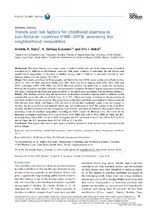| dc.description.abstract | BACKGROUND: Diarrheal diseases are a major cause of child mortality and one of the main causes of medical
consultation for children in sub-Saharan countries. This paper attempts to determine the risk factors and
neighborhood inequalities of diarrheal morbidity among under-5 children in selected countries in sub-
Saharan Africa over the period 1990 2013.
DESIGN: Data used come from the Demographic and Health Survey (DHS) waves conducted in Burkina Faso
(1992 93, 1998 99, 2003, and 2010), Mali (1995, 2001, 2016, and 2012), Nigeria (1990, 1999, 2003, 2008, and
2013), and Niger (1992, 1998, 2006, and 2012). Bivariate analysis was performed to assess the association
between the dependent variable and each of the independent variables. Multilevel logistic regression modelling
was used to determine the fixed and random effects of the risk factors associated with diarrheal morbidity.
RESULTS: The findings showed that the proportion of diarrheal morbidity among under-5 children varied
considerably across the cohorts of birth from 10 to 35%. There were large variations in the proportion of
diarrheal morbidity across countries. The proportions of diarrheal morbidity were higher in Niger compared
with Burkina Faso, Mali, and Nigeria. The risk factors of diarrheal morbidity varied from one country to
another, but the main factors included the child's age, size of the child at birth, the quality of the main floor
material, mother's education and her occupation, type of toilet, and place of residence. The analysis shows an
increasing trend of diarrheal inequalities according to DHS rounds. In Burkina Faso, the value of the
intraclass correlation coefficient (ICC) was 0.04 for 1993 DHS and 0.09 in 2010 DHS; in Mali, the ICC
increased from 0.04 in 1995 to 0.16 in 2012; in Nigeria, the ICC increased from 0.13 in 1990 to 0.19 in 2013;
and in Niger, the ICC increased from 0.07 in 1992 to 0.11 in 2012. | en_US |


